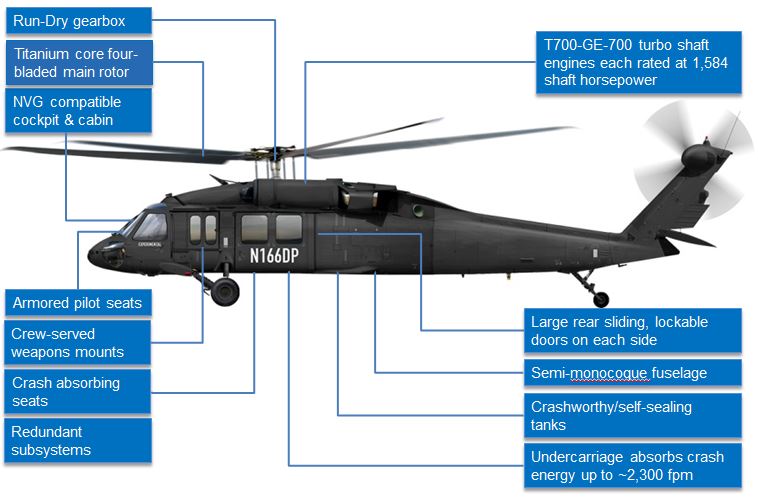UH 60 Helicopter Maintenance: A Comprehensive Overview for Pilots
Comprehending the Mechanics and Engineering Behind Uh 60 Helicopters
The UH-60 helicopter, commonly understood as the Black Hawk, stands as a pinnacle of modern rotorcraft technology, symbolizing a mix of durable engineering and intricate mechanics. As we peel back the layers of the UH-60's design, a world of complex systems and thorough design comes to light.
Background of UH-60 Helicopters
The history of UH-60 helicopters traces back to the late 1970s when the USA Military sought a advanced and functional energy helicopter to change its aging fleet. In reaction to this need, the Sikorsky Airplane Firm established the UH-60 Black Hawk helicopter. Introduced in 1979, the UH-60 rapidly came to be a staple in military procedures because of its outstanding abilities.
The UH-60 was designed to master a range of missions, consisting of army transportation, medical discharge, digital warfare, and unique operations. Its capability to adjust to various roles made it a beneficial possession to the U.S. uh 60. Army and various other military pressures all over the world
Over the years, the UH-60 system has undergone numerous upgrades and variations to boost its performance and equal progressing goal demands. These helicopters have actually seen considerable service in problems such as the Gulf Battle, Afghanistan, and Iraq, showcasing their reliability and adaptability in diverse operational settings. The UH-60's rich history is a testament to its long-lasting legacy as a leading energy helicopter.

Engine and Power Systems
Using advanced propulsion technology, UH-60 helicopters are equipped with advanced engine and power systems to guarantee optimal performance and integrity in a variety of operational scenarios. The UH-60, typically called the Black Hawk, is powered by two General Electric T700-GE-701D engines, each with the ability of delivering up to 1,940 shaft horsepower. These turboshaft engines provide the necessary thrust for the helicopter to execute its objectives successfully, including army transportation, medical evacuation, and fight support.

Rotor System and Aerodynamics
Exactly how do the rotor system and aerodynamics of UH-60 helicopters add to their functional effectiveness and flight capabilities? The rotor system of the UH-60 helicopter plays a crucial role in giving lift and propulsion.
The rules of aerodynamics likewise play a crucial role in the efficiency of UH-60 helicopters. The structured fuselage and blades blade style decrease drag, allowing the helicopter to attain higher speeds and far better fuel efficiency. The aerodynamic layout of the UH-60 likewise adds to its capability to operate in varied ecological conditions, consisting of hot temperatures and high elevations.
Avionics and Flight Control Equipment

In its intricate control with the rotor system and aerodynamics of UH-60 helicopters, the avionics and flight control systems create a crucial network of innovations forming the aircraft's operational abilities. In the UH-60, these systems consist of electronic display screens, interaction radios, General practitioner navigating, weather radar, and autopilot systems.
The flight control systems of the UH-60 are in charge of equating the pilot's inputs into the proper changes to the blades system, making certain stable trip and maneuverability. These systems include hydraulic actuators, servos, and computer systems that interact to regulate the major and tail rotors, in addition to other flight control surfaces. By exactly handling the helicopter's trip characteristics, these systems make it possible for pilots to execute a large range of missions, from transport and search-and-rescue to right here fight operations, with precision and confidence.
Role and Applications in Aviation
The function and applications of avionics and trip control systems in resource aeronautics are indispensable to making certain the reliable and secure procedure of airplane, including UH-60 helicopters. Avionics systems in UH-60 helicopters include a variety of electronic systems that help in navigating, interaction, surveillance, and managing different aircraft features. These systems consist of electronic display screens, auto-pilot systems, interaction radios, general practitioner navigating devices, and weather condition radar. Flight control systems play an important role in maneuvering the helicopter airborne, preserving stability, and making certain accurate movements. The fly-by-wire modern technology utilized in modern UH-60 helicopters converts pilot inputs right into electronic signals, which are after that translated by the trip control computer systems to readjust the aircraft's control surfaces. Furthermore, these systems incorporate safety and security functions such as autopilot settings, terrain awareness alerting systems, and stability enhancement systems to enhance the overall safety and security and operational capacities of the UH-60 helicopters in different goals, including army transportation, find out this here medical emptying, search and rescue, and aerial firefighting.
Conclusion
In final thought, the UH-60 helicopter is a functional airplane with a rich background and progressed design. Its engine and power systems, rotor system, aerodynamics, avionics, and trip control systems all collaborate to make it a dependable and effective device. The UH-60's function and applications in aeronautics are large, ranging from army operations to browse and rescue objectives. Its proceeded growth and use show its relevance in the area of air travel (uh 60).
In its elaborate coordination with the rotor system and aerodynamics of UH-60 helicopters, the avionics and trip control systems create an essential network of innovations shaping the aircraft's operational capacities.The trip control systems of the UH-60 are accountable for converting the pilot's inputs right into the ideal modifications to the rotor system, guaranteeing stable trip and ability to move. Avionics systems in UH-60 helicopters encompass a variety of electronic systems that help in navigation, interaction, monitoring, and controlling numerous aircraft features. Furthermore, these systems incorporate safety and security functions such as auto-pilot modes, surface awareness warning systems, and security enhancement systems to enhance the total safety and security and operational capacities of the UH-60 helicopters in different objectives, consisting of troop transport, clinical emptying, search and rescue, and aerial firefighting.
Its engine and power systems, blades system, aerodynamics, avionics, and trip control systems all work with each other to make it a efficient and reliable machine.